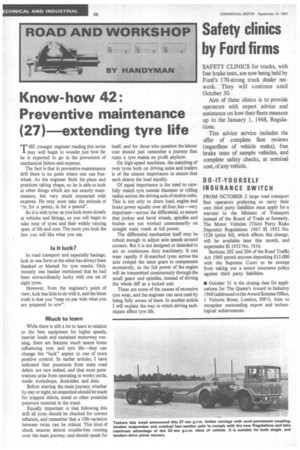Know-how 42: Preventive maintenance (27) extending tyre life
Page 58

If you've noticed an error in this article please click here to report it so we can fix it.
rr HE younger engineer reading this series may well begin to wonder just how far he is expected to go in the prevention of mechanical failure and expense.
The fact is that in preventive maintenance drill there is no point where one can freewheel. As the engineer finds his plans and practices taking shape, so he is able to look at other things which are not exactly maintenance, but very much connected with expense. He may soon take the attitude of "in for a penny, in for a pound".
So it is with tyres: as you look more closely at vehicles and fittings, so you will begin to take note of tyres and their widely varying span of life and cost. The more you look the less you will like what you see.
Is it luck?
In road transport and especially haulage, luck in one form or the other has always been thanked or blamed for tyre results. Only recently one haulier mentioned that he had been extraordinarily lucky with one set of eight tyres.
However, from the engineer's point of view, luck has little to do with it, and the blunt truth is that you "reap on par with what you are prepared to sow".
Much to learn While there is still a lot to learn in relation to the best equipment for higher speeds, heavier loads and sustained motorway running, there are features much nearer home influencing cost and tyre life—they can change the "luck" aspect to one of more positive control. In earlier articles, I have indicated that punctures from main road debris are rare indeed, and that most penetrations arise from operating in works yards, inside workshops, docksides and sites.
Before starting the main journey, whether by day or night, an inspection should be made for trapped debris, metal or other potential puncture material in the tread.
Equally important is that following this drill all tyres should be checked for correct inflation, and remember that a 101b variation between twins can be critical. This kind of check ensures almost trouble-free running over the main journey, and should speak for itself, and for those who question the labour cost should just remember a journey that ruins a tyre makes no profit anyhow.
On high-speed machines, the matching of twin tyres both on driving axles and trailers is of the utmost importance to ensure that each shares the load equally.
Of equal importance is the need to carefully match tyre outside diameter or rolling radius across the driving axle of motive units. This is not only to share load, engine and brake power equally over all four, but—very important—across the differential, to ensure that jockey and bevel wheels, spindles and bushes are not worked unnecessarily on straight main roads at full power.
The differential mechanism itself may be robust enough to adjust axle speeds around corners. But it is not designed or intended to act as continuous duty machinery. It can wear rapidly if ill-matched tyres across the axle compel the inner gears to compensate excessively, as the full power of the engine will be transmitted continuously through the small gears and spindles, instead of driving the whole cliff as a locked unit.
These are some of the causes of excessive tyre wear, and the engineer can save cash by being fully aware of them. In another article I will explain the way in which driving techniques affect tyre life.




































































































































